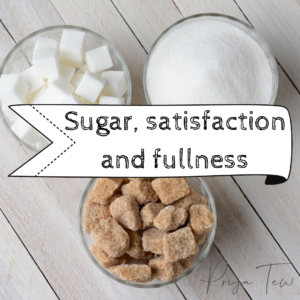Sugar can be such a confusing area, it is one of the areas I am asked about a lot. What types of sugar can I eat? Should I go sugar free? Is sugar bad? Whilst a sugar free diet may feel like a sensible approach, the reality is this can often be another fad diet. Finding a balanced long term approach where you are not deprived and can eat all the foods you love is far better than jumping from diet to diet. Eating more on some occasions doesn’t mean you need to diet it off afterwards. Our weight naturally fluctuates after holidays and occasions where we eat differently, a combination of eating nutritious foods and moving your body daily is always better than that new detox trend or fad diet.
Ever noticed that when you have one of your favourite sweeter foods it makes you want more? This could be because you have been too restrictive. If you make a food as off-limits it can make you desire it more. So let’s have all foods as good, all foods as allowed and all foods on the menu, with a huge serving of common sense and self-compassion too.

Sometimes eating sweeter foods satisfies that taste craving but doesn’t keep you full up and leaves you wanting more. Think about eating chocolate chip cookies compared to a slice of toast with peanut butter. Both are delicious but after the cookies you may find yourself looking for another snack, whereas that toast would me more likely to keep you going until the next meal. Eating foods that cause a big increase in your blood sugars can then lead to a large drop that makes you crave even more sugar. Having the sweeter foods at the end of a meal is a great way to help lower the glycaemic index of a meal, plus most people fancy something sweet to end a meal. When you want a sweeter snack, try adding fibre or protein in too, for example those chocolate chip cookies with a handful of nuts. This adds nutrition and also helps stabilise those blood sugar changes. Another alternative is using a sugar such as Palantinose, which causes a slower rise in blood sugar levels and is also kind to teeth.
On a chemical level, sugars or saccharides are made up of 3 simple units: Carbon, Hydrogen and Oxygen, it is that simple! There are 3 main building blocks of sugars: glucose, fructose and galactose, galactose isn’t one we come across that often however. These are all monosaccharides, meaning they are one sugar molecule. These three types of sugars can then combine to make lactose (in milk), maltose (malt sugar) and sucrose, our common table sugar. To make another other sugar, you just add different amounts of each sugar to get the right mix, it’s like baking a cake!
Lactose = glucose and galactose
Maltose = glucose and glucose
Sucrose = fructose and glucose
So there isn’t a need to be intimidated by sugar, instead it is key to be informed. There are so many different names we use for sugar, here are some of them:
| Agave | Demerera | Malt Syrup |
| Blackstrap Molasses | Dextrose | Maltose |
| Brown Sugar | D-Mannose | Maple Syrup |
| Cane Sugar | Fruit Juice | Molasses |
| Caramel | Galactose | Muscovado |
| Carob Syrup | Golden Syrup | Rice Syrup |
| Corn Syrup | High Fructose Corn Syrup | Sorghum Syrup |
| Date Syrup | Icing | Treacle |
You may be surprised where sugar is found. That is because it doesn’t sweeten foods, it can help prevent spoilage too. Whilst we live in a high sugar world, we don’t need to cut out sugar, or any food. All foods can be eaten, enjoyed and be part of a balanced diet. Instead, know what you are eating and think about the satisfaction it brings you.